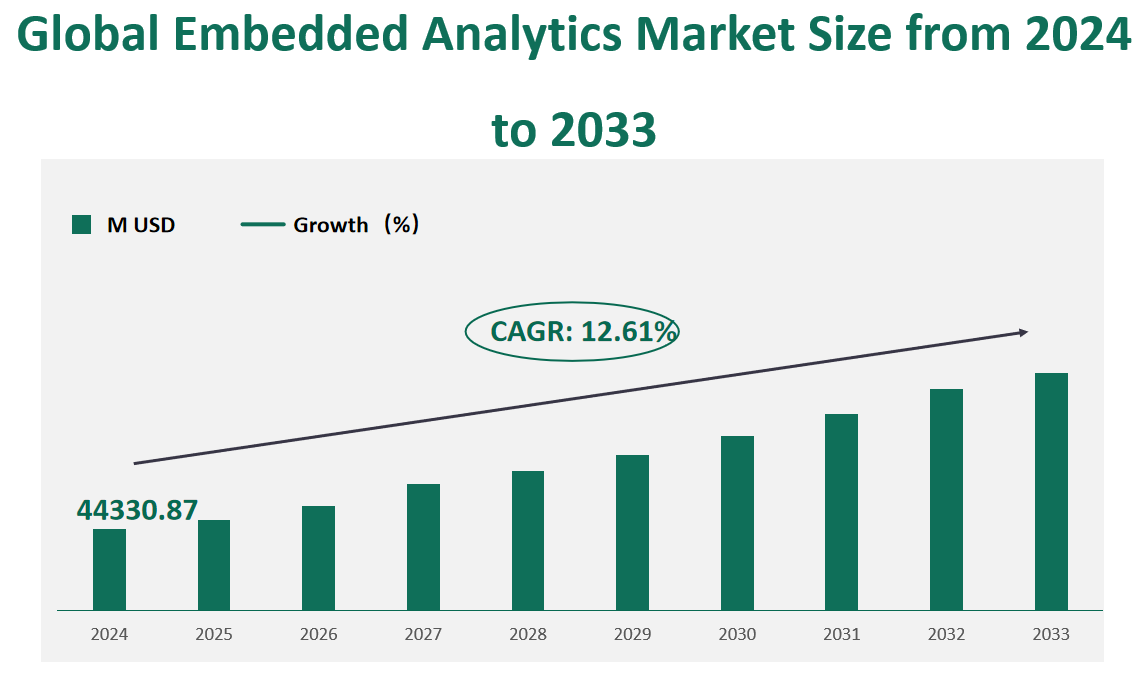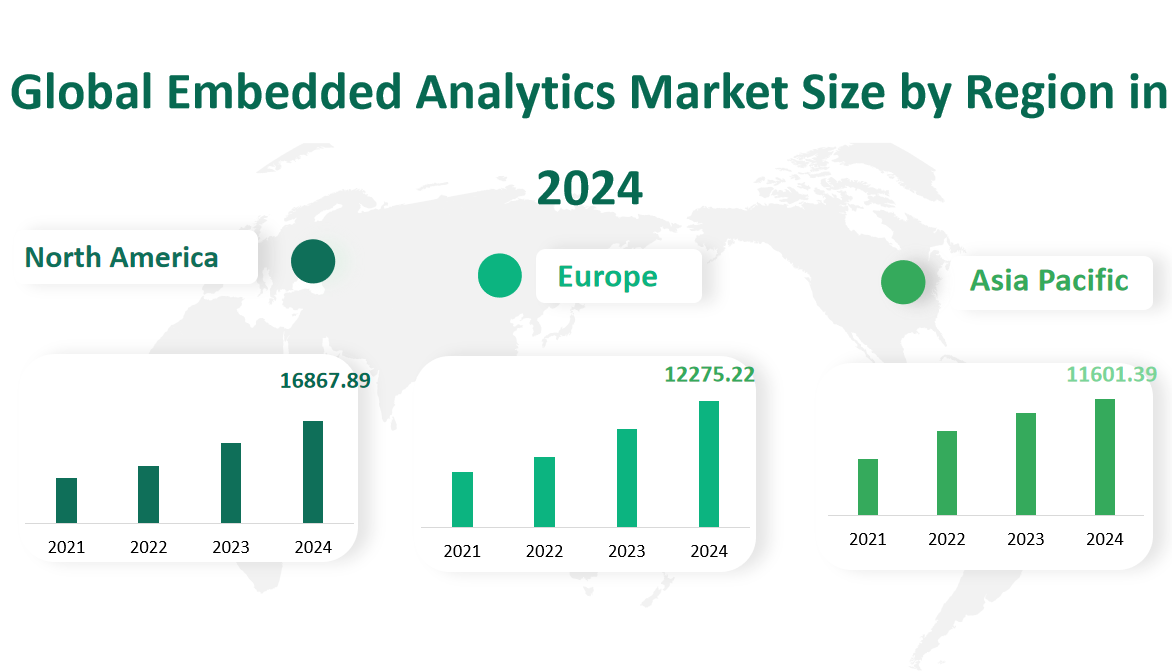1 Global Embedded Analytics Market Insight Analysis
The global Embedded Analytics market is expected to be valued at USD 44,330.87 million by 2024, with a CAGR of 12.61% from 2024 to 2033.
Embedded analytics is the integration of analytic content and capabilities within applications, such as business process applications (e.g., CRM, ERP, EHR/EMR) or portals (e.g., intranets or extranets).
The goal is to help users work more intelligently by integrating and analyzing relevant data. Users can directly use these data analysis functions in daily business systems to solve high-value business problems and improve work efficiency.
Figure Global Embedded Analytics Market Size (M USD) and CAGR (2024-2033)

2 Embedded Analytics Market Growth Drivers and Restraints
The Embedded Analytics market is experiencing rapid growth, with a multitude of factors contributing to this expansion. One of the primary drivers is the increasing importance of data-driven decision-making in businesses across various sectors. Companies are recognizing the value of leveraging embedded analytics to gain insights from their data, leading to more informed strategic planning and operational efficiency. The proliferation of big data and the need for real-time analytics have further fueled the demand for embedded analytics solutions.
Technological advancements, particularly in the areas of artificial intelligence (AI) and machine learning (ML), have made analytics more powerful and accessible. These technologies enable embedded analytics platforms to offer predictive and prescriptive analytics, providing businesses with a competitive edge. The growing adoption of cloud computing has also facilitated the deployment of embedded analytics, offering scalability and flexibility.
Another significant driver is the digital transformation initiatives undertaken by organizations worldwide. As companies move to digitize their operations, the need for robust analytics capabilities embedded within business processes becomes essential. This trend is expected to continue, contributing to the growth of the embedded analytics market.
However, the market faces certain limitations that could hinder its growth. Data security and privacy concerns are paramount, as the collection and analysis of vast amounts of data carry inherent risks. Companies must ensure that their analytics solutions comply with regulations such as GDPR and invest in robust security measures to protect sensitive information.
The high initial cost of implementing advanced analytics solutions can be a barrier for some organizations, particularly small and medium-sized enterprises (SMEs). Additionally, the need for specialized skills to manage and interpret analytics results poses a challenge, as there is a shortage of professionals with the required expertise in data science and analytics.
The market also faces the challenge of product convergence, where the offerings of different vendors become increasingly similar, making it difficult for companies to differentiate their products and services. This competition could lead to price wars, affecting the profitability of market players.
3 Technological Innovations and Mergers in the Embedded Analytics Market
Innovations in technology have been a key driver in the Embedded Analytics market, with AI and ML at the forefront. These technologies enable platforms to provide more than just descriptive analytics; they can now offer predictive and prescriptive insights, helping businesses to not only understand what has happened but also to forecast and strategize for the future. Natural language processing (NLP) has also seen significant advancements, allowing for more intuitive interactions with analytics platforms, making them more user-friendly and accessible to non-technical users.
The rise of the Internet of Things (IoT) has created new opportunities for embedded analytics, as the vast amounts of data generated by connected devices require real-time analysis for actionable insights. Edge computing is another technological development that complements embedded analytics by processing data closer to the source, reducing latency and enabling faster decision-making.
Corporate mergers and acquisitions (M&A) have played a significant role in shaping the Embedded Analytics market. Larger companies have been acquiring smaller, innovative startups to bolster their analytics capabilities and expand their market share. These M&A activities have led to the consolidation of the market, with a few key players dominating the landscape. For example, Salesforce’s acquisition of Tableau Software is a notable event that brought together the world’s leading CRM platform with a top analytics platform, enhancing the digital transformation capabilities for customers.
However, the high concentration of market players also raises concerns about competition and innovation. The market may become less dynamic if a few companies control a significant share, potentially stifering innovation and increasing the barriers to entry for new competitors. Despite this, the Embedded Analytics market continues to attract investment, indicating confidence in its growth potential and the value of data analytics in the digital economy.
4 Global Embedded Analytics Market Size by Type
Information Technology: This segment is expected to command a substantial share of the market, with a forecasted revenue of $4,707.94 million USD in 2024. The IT sector’s reliance on embedded analytics for system optimization, cybersecurity, and infrastructure management is a key driver for this segment’s growth.
Marketing and Sales: With an anticipated revenue of $12,634.30 million USD, this segment is projected to be the largest in 2024. Embedded analytics in marketing and sales enables businesses to understand customer behavior, optimize campaigns, and enhance customer engagement, making it a critical component of modern marketing strategies.
Finance: Financial institutions are expected to allocate substantial resources to embedded analytics, with a forecasted market size of $9,792.69 million USD. This technology is vital for risk assessment, fraud detection, and regulatory compliance in the financial sector.
Production: The production segment is anticipated to generate $8,622.35 million USD in 2024. Embedded analytics plays a crucial role in supply chain management, quality control, and operational efficiency within the production industry.
Human Resources: With a projected revenue of $4,074.01 million USD, embedded analytics in HR helps organizations with talent management, employee performance tracking, and workforce planning.
Table Global Embedded Analytics Market Size and Share by Type in 2024
|
Type |
Market Size (M USD) 2024 |
Market Share 2024 |
|---|---|---|
|
Information Technology |
4707.94 |
10.62% |
|
Marketing and Sales |
12634.30 |
28.50% |
|
Finance |
9792.69 |
22.09% |
|
Production |
8622.35 |
19.45% |
|
Human Resources |
4074.01 |
9.19% |
|
Others |
4499.58 |
10.15% |
5 Global Embedded Analytics Market Size by Application
Independent Software Vendor (ISV): ISVs are anticipated to hold a substantial market share, with revenues projected to reach $23,783.51 million USD. This segment’s growth is attributed to the increasing need for customized software solutions that integrate advanced analytics capabilities.
Information Providers: This application area is expected to generate $11,002.92 million USD, underpinned by the rising demand for data-centric services and the proliferation of information-driven businesses.
IoT Sectors: With the IoT revolution, this segment is projected to see a significant uptick, with revenues estimated at $5,625.59 million USD. The integration of analytics within IoT devices facilitates real-time decision-making and enhances operational efficiencies.
Table Global Embedded Analytics Market Size and Share by Application in 2024
|
Application |
Market Size (M USD) 2024 |
Market Share 2024 |
|---|---|---|
|
Independent Software Vendor (ISV) |
23783.51 |
53.65% |
|
Information Providers |
11002.92 |
24.82% |
|
IoT Sectors |
5625.59 |
12.69% |
|
Others |
3918.85 |
8.84% |
6 Global Embedded Analytics Market Size by Region
North America: With a forecasted revenue of $16,867.89 million USD, North America is expected to maintain its lead due to the region’s early adoption of advanced analytics technologies and a mature digital infrastructure.
Europe: Europe is projected to generate $12,275.22 million USD, with growth driven by the region’s strong focus on data privacy and the implementation of stringent data protection regulations.
Asia Pacific: This region is anticipated to see significant growth, with revenues estimated at $11,601.39 million USD. The rapid economic development and the increasing demand for data analytics in countries like China and India are key factors contributing to this growth.
Latin America: With a projected revenue of $2,181.08 million USD, Latin America is expected to experience steady growth, albeit from a smaller base, as the region catches up in terms of digital transformation.
Middle East & Africa: This region is expected to contribute $1,405.29 million USD, with the market driven by the oil-rich Gulf states’ investments in advanced analytics for improved operational efficiencies.
The regional disparities in the Embedded Analytics market are influenced by factors such as economic development, technological adoption rates, and regulatory environments. North America and Europe, with their mature markets, continue to lead in terms of revenue generation, while Asia Pacific and Latin America are experiencing rapid growth due to their emerging economies and increasing digitalization efforts. The Middle East & Africa region, although starting from a smaller base, is also investing in analytics to drive economic diversification and improve operational efficiencies.
Figure Global Embedded Analytics Market Size (M USD) by Region in 2024

7 Global Embedded Analytics Market Analysis by Major Players
7.1 Oracle
Company Introduction and Business Overview:
Oracle, established in 1977 and headquartered in the USA, is a leading global enterprise technology software company with a widespread business distribution.
Oracle offers a comprehensive suite of integrated applications for various business functions, including Sales, Service, Marketing, and Finance, along with Highly Automated and Secure Generation 2 Infrastructure featuring the Oracle Autonomous Database.
Products:
Oracle Analytics Cloud, which is embedded with machine learning, empowers leaders, analysts, and IT to access data from various sources, including mobile devices, and gain impactful insights to make informed decisions.
7.2 IBM Corporation
Company Introduction and Business Overview:
IBM Corporation, founded in 1911 and with operations in over 170 countries, is an American multinational technology company headquartered in Armonk, New York.
IBM produces and sells computer hardware, middleware, and software, and provides hosting and consulting services in areas ranging from mainframe computers to nanotechnology.
Products:
Cognos Analytics, which enables users to build reports, dashboards, and interactive visualizations on top of virtually any data source, whether on cloud or on premise.
7.3 SAS Institute
Company Introduction and Business Overview:
SAS Institute, established in 1976 and operating worldwide, is recognized as the leader in business analytics software and services and the largest independent vendor in the business intelligence market.
SAS helps customers at over 70,000 sites improve performance and deliver value by making better decisions faster through innovative solutions.
Products:
SAS® Visual Analytics, a single application for reporting, data exploration, and analytics, utilizes machine learning and natural language explanations to find, visualize, and narrate stories and insights.

